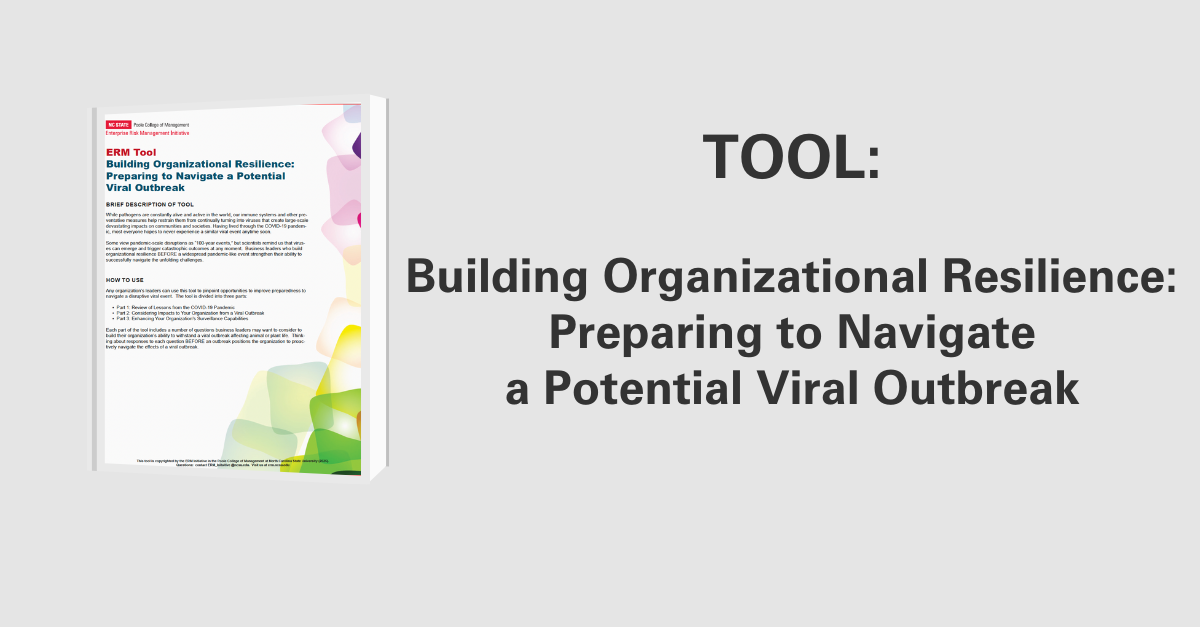Using ERM to Navigate Coronavirus and Other Pandemic Risk Events
5 Essential Risk Lessons COVID-19 Taught Business Leaders
 The COVID-19 pandemic was more than a health crisis—it was a live stress test for every organization’s risk management systems. Suddenly, executives across industries were forced to respond, adapt, and rethink how risks are identified, assessed, and mitigated.
The COVID-19 pandemic was more than a health crisis—it was a live stress test for every organization’s risk management systems. Suddenly, executives across industries were forced to respond, adapt, and rethink how risks are identified, assessed, and mitigated.
In a 2020 Financial Management webinar and interview, Mark Beasley, CPA and director of the Enterprise Risk Management (ERM) Initiative at NC State University, reflected on the profound lessons the pandemic taught business leaders. His insights offer a roadmap for how companies can better prepare for the next disruption.
Let’s explore the five core principles Beasley believes should guide today’s risk strategies.
Put People First: Risk Management Starts with Empathy
The pandemic disrupted not only markets but lives. Homes turned into offices, children attended school online, and work-life boundaries blurred. Stress and uncertainty surged. Beasley emphasized that organizations must put people at the center of their risk management responses.
Executives should communicate with empathy, recognizing the emotional and practical strain on their workforce. Supportive messaging from leadership is vital. As Beasley noted, “The workforce has been thrown into an uncertain world… and it’s not easy.”
Moreover, remote work has opened new possibilities. Organizations can now tap into talent far beyond their geographic footprint. “I can have talent working for NC State, and they live in California. Why not?” Beasley added.
Key takeaway: Risk management isn’t just about systems—it’s about people. Prioritize mental health, work-life flexibility, and virtual collaboration tools.
Identify the “Main Thing”: Focus on Core Business Priorities
In times of crisis, clarity is critical. Beasley urged leaders to double down on their core offerings—the “main thing” that sustains their business.
Using the example of a hotel that cut back on frills like happy hours and daily cleanings during the pandemic, Beasley highlighted that shedding nonessentials can be a sound risk response. The essential product or service must remain uninterrupted, even if everything else is scaled back.
This principle forces leadership to evaluate what truly drives value. What can be trimmed or paused without sacrificing the company’s mission or financial stability?
Key takeaway: A streamlined focus helps conserve resources and reduces exposure to peripheral risks.
Identify Risks: Anticipate What Could Derail the “Main Thing”
New risks emerged rapidly during the pandemic—from remote work cybersecurity to supply chain breakdowns. Beasley stressed the importance of proactively asking: What could keep our core offering from being delivered?
As a professor preparing to teach online, Beasley faced risks like students lacking internet access or instructors missing the right technology. Businesses faced similar hurdles. The number of risks didn’t just grow—it exploded.
“Multiple uncontrolled risks are on steroids,” he warned. Whereas pre-pandemic challenges might arise one at a time, leaders today must manage concurrent, compounding threats.
Key takeaway: Prioritize a structured risk identification process that scans for both internal weaknesses and external shocks.
Respond to Risks: Avoid Perfection Paralysis
Perfect is the enemy of good, especially during a crisis. Beasley advised business leaders to abandon perfectionist tendencies when responding to risk events. Instead, make the best decisions possible with the available information.
“Let’s respond the best way we can, but let’s not wait until we can get the perfect response,” he explained. Agile responses are often more effective than flawless, delayed ones.
Additionally, the pandemic has nudged many executives to reconsider their reluctance toward scenario planning. Once dismissed as “unlikely,” black swan events have proven to be costly when ignored.
Key takeaway: Develop flexible response plans and run “what-if” simulations. The value lies not in predicting the exact scenario but in improving response capability.
Monitor and Communicate: Stay Short-Term Focused in Uncertainty
Planning far into the future can be risky when the present is still volatile. Beasley recommended that organizations focus on short-term adaptability, continuously monitoring both internal data and external trends.
“The crisis is still so real,” he said. “The uncertainty is changing so rapidly.” In such times, leaders should avoid locking into long-term strategies prematurely.
However, communication must remain consistent and clear. Whether engaging stakeholders, employees, or customers, transparency builds trust and reduces confusion.
Some pandemic-era innovations may become permanent. From remote budgeting to grocery pick-up for elderly users, behaviors have shifted—and organizations must adjust.
Key takeaway: Embrace near-term planning cycles, but keep communication fluid and frequent to align responses across teams.
COVID-19 as a Wake-Up Call for Risk Leadership
Perhaps the most enduring insight Beasley offered is this: risk management is no longer optional. The pandemic exposed how quickly a single root-cause event can spiral into an enterprise-wide crisis.
Executives who once postponed risk planning—believing “we don’t have time for this”—are now seeing the cost of inaction. According to Beasley, many are thinking, “Ooh, it would have been really helpful had we done that.”
This shift in mindset is the silver lining. Risk management is gaining the attention it deserves at the highest levels of leadership.
Final Thoughts: Future-Proofing with Lessons from the Past
The five principles Mark Beasley outlines—centering people, focusing on the core, identifying new threats, responding with agility, and monitoring change—are not just pandemic lessons. They’re pillars of resilient enterprise risk management.
As we look to a post-COVID future, businesses that internalize these lessons will be better equipped to survive—and thrive—when the next disruption hits.
Original Source: 5 risk management lessons from the coronavirus pandemic, Financial Management Magazine


